lecture 4.文化与翻译
lecture 5.文化与翻译
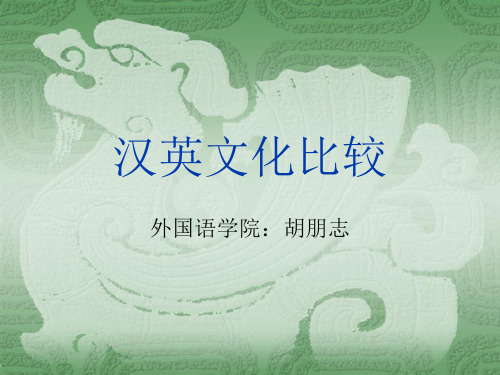
成语中的文化
突出表现为概念相似(denotation)、语用意义
(connotation)不同 1.打草惊蛇----to beat about the bush 打草惊蛇: to alert the enemy by rush or accidental events before carrying out the planned attack; to beat about the bush: to approach a subject without coming to the point, try to say something indirectly(旁敲侧击). 2. 翻天覆地----to move heaven and earth 翻天覆地:epoch-making, earth-shaking To move heaven and earth: to do one’s utmost (千方百计)
第三节 文化与翻译
词义相符(semantic correspondence):指称
意义和蕴涵意义相符; 词义相异(semantic non-correspondence): 指称意义相符但蕴涵意义相异,或者指指 称意义与蕴涵意义均相异; 词义空缺(semantic zero):汉语词语的指称 意义或蕴涵意义在英语中不存在,造成零 指称意义或零蕴涵意义。
一见面是寒暄,寒暄之后说我“胖了”,说我“胖了”之后
即大骂新党。(《祝福》)(greeting/polite remarkes; revolutionaries) When we met, after exchanging a few polite remarks he said I was fatter, and after saying that immediately started a violent attack on the revolutionaries. After exchanging a few polite remarks when we met, he observed that I looked “fat”, and having made that complimentary remark he launched a violent attack on the revolutionaries. 毛主席问陈妻:“你们俩感情好不好?”,陈妻答:“好。” 主席听了感到非常高兴。(长辈或上级的关心) Then Chairman Mao talked with Chen’s wife. He was pleased to know that they had a happy home life. (翻译时化直接为间接,化具体为模糊)
S CET-4翻译新题型 C4606

CET-4翻译新题型陈河Lecture One: Lead-in“一个中心和两个基本点”就翻译实质而言,它是不同语言(code)之间的(decode)解码和编码(encode),即拆分组合的过程。
所以不管是四六级翻译还是考研翻译,亦或其他翻译实践,都需把握“一个中心和两个基本点”。
Ⅰ. “一个中心”原则---以理解原文为中心:Ⅱ.“两个基本点”---词汇和句型:词汇是句子的“血肉”,句子是段落的“骨骼”;翻译中准确的用词,合理的句子结构缺一不可(很多同学误以为仅掌握词汇就足够,谬矣!)Lecture Two: 汉译英实用技巧1.词的翻译⑴词义选择:准确选词是保证译文质量的核心环节,如能做到在词语含义和字面形式上都相符最好,如不能,则取含义舍形式。
e.g. 现在全世界各地都在学习普通话Nowadays, Putonghua/mandarin is being learned all across the whole world;开小灶:to give students special tuition;墙头草:to sit on the fence⑵词性转换:汉语动词很少借用其它词类来表达动词含义,多呈动态;而英语可借助名词、形容词和介词等来表达动作,比较而言多呈静态。
译者可酌情把汉语动词(短语)转译为英语名词(短语)或介词(短语)等。
e.g. 中国人重视孝道,是由于在传统上不看重功利;Chinese people’s emphasis on filial piety is attributed to their traditional neglect of material gain.⑶增词翻译:增译法的主要作用有:一是保证英文译文语法结构完整,二是保证英文译文意思清晰准确。
具体译法:一是根据语境补全主语;二是增补英文句中表示逻辑关系的词(组)。
e.g. 面对青山绿水,将烦扰抛到脑后。
When facing the green hills and clear water, you forget all your worries and annoyance.我国的端午节时纪念屈原的日子。
道教文化与汉英翻译

道教文化与汉英翻译Taoist Culture and C-E Translation▪道教文化背景知识Taoist Culture道家Philosophical Taoism道敎Religious Taoism起源:OriginTaoist organizations:张道陵Zhang Daoling 五斗米道西晋Taoist doctrines:老子李耳Laozi 唐高祖李渊Tang Dynasty老子Laozi▪老子Laozi, honorific title老“venerable”, “old”子“master”, honorific suffix李耳Li Er, 字伯阳Boyang (courtesy name)▪道家学派始祖founder of philosophical Taoism▪《道德经》Tao Te Ching▪宇宙哲学Chinese cosmogony▪信仰:Beliefs▪Tao “way”, “path”▪無為Wu wei “without action”无为而治,不言之教Hayek:spontaneous orderJames Dorn: minimizing the role of government and letting individuals develop spontaneously would best achieve social and economic harmony.▪三宝▪慈compassion俭moderation (Thrift)不敢为天下先humility▪朴simplicity, the primordial state of tao▪去甚,去奢,去泰Discarding extremes, extravagance and excess▪少私寡欲wipe out selfish desires▪清静恬淡live a quiet life/ quiet world▪知足常乐the attitude of contentment on what one owns道教经典英译▪道生一,一生二,二生三,三生万物。
法国语言与文化第四课lecture翻译
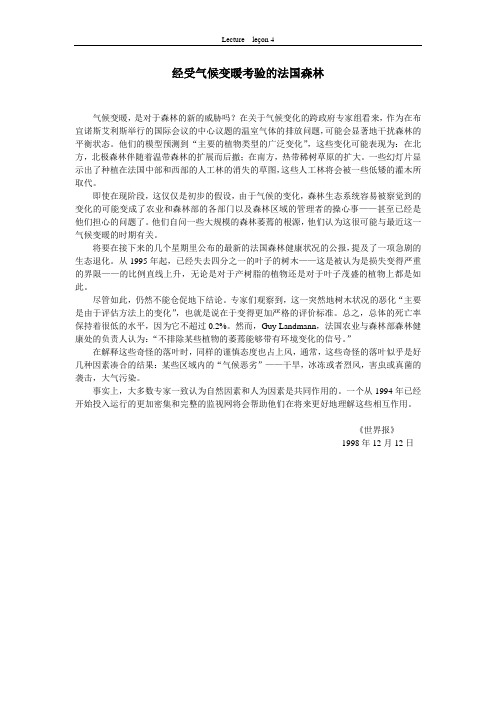
Lecture leçon 4经受气候变暖考验的法国森林气候变暖,是对于森林的新的威胁吗?在关于气候变化的跨政府专家组看来,作为在布宜诺斯艾利斯举行的国际会议的中心议题的温室气体的排放问题,可能会显著地干扰森林的平衡状态。
他们的模型预测到“主要的植物类型的广泛变化”,这些变化可能表现为:在北方,北极森林伴随着温带森林的扩展而后撤;在南方,热带稀树草原的扩大。
一些幻灯片显示出了种植在法国中部和西部的人工林的消失的草图,这些人工林将会被一些低矮的灌木所取代。
即使在现阶段,这仅仅是初步的假设,由于气候的变化,森林生态系统容易被察觉到的变化的可能变成了农业和森林部的各部门以及森林区域的管理者的操心事——甚至已经是他们担心的问题了。
他们自问一些大规模的森林萎蔫的根源,他们认为这很可能与最近这一气候变暖的时期有关。
将要在接下来的几个星期里公布的最新的法国森林健康状况的公报,提及了一项急剧的生态退化。
从1995年起,已经失去四分之一的叶子的树木——这是被认为是损失变得严重的界限——的比例直线上升,无论是对于产树脂的植物还是对于叶子茂盛的植物上都是如此。
尽管如此,仍然不能仓促地下结论。
专家们观察到,这一突然地树木状况的恶化“主要是由于评估方法上的变化”,也就是说在于变得更加严格的评价标准。
总之,总体的死亡率保持着很低的水平,因为它不超过0.2%。
然而,Guy Landmann,法国农业与森林部森林健康处的负责人认为:“不排除某些植物的萎蔫能够带有环境变化的信号。
”在解释这些奇怪的落叶时,同样的谨慎态度也占上风,通常,这些奇怪的落叶似乎是好几种因素凑合的结果:某些区域内的“气候恶劣”——干旱,冰冻或者烈风,害虫或真菌的袭击,大气污染。
事实上,大多数专家一致认为自然因素和人为因素是共同作用的。
一个从1994年已经开始投入运行的更加密集和完整的监视网将会帮助他们在将来更好地理解这些相互作用。
《世界报》1998年12月12日。
文化与翻译 ppt课件

land oneself in serious trouble
be unable to stand
ppt课件
19
Terms relating to “吃”:
吃老本
吃软不吃硬
吃闲饭 吃香
live off one’s past gains
be open to persuasion, but not to coercion
一丘之貉。 birds of a feather: people of similar interests or
personalities 兴趣爱好相同的人/同类人 物以类聚,人以群分。
in a context denoting bad persons 一路货,臭味相投者
ppt课件
14
Gild the lily
15
Shakespeare: King John
“To gild refined gold, to paint the lily…is wasteful and ridiculous excess. ”
ppt课件
16
In China, when people meet…
甲:“吃了吗?” 乙:“吃啦!”
the term has no implications of high development.
ppt课件
5
Language is not isolated.
Every language belongs to a certain culture.
It is difficult to separate language and cultural identity.
《翻译理论与实践(笔译)》期末复习辅导 - 萧山电大讲解

浙江广播电视大学英语专业(开放专科)《英语翻译基础》期末复习一、考试题型和模拟题1. 选择题:10题,每题2分,共20分。
范围主要包括翻译标准,直译与意译问题,翻译的定义,文化与翻译的问题。
2. 问答题:1题,共10分。
范围主要包括直译与意译问题,翻译的标准,以及翻译与文化的关系等等。
3.改译句子:10题,共30分。
3. 段落翻译(英译汉):2段,共40分。
一、选择题(在四个选项中选择一个正确答案):1. 明朝末年的翻译家徐光启主要从事--- ---的翻译。
A. 佛教经典B. 文学作品C. 科技著作D. 哲学著作2. 《马氏文通》的作者马建忠提出了“--- ---”的翻译观点。
A. 善译B. 化境C. 神似D. 信、达、雅3. 出版后即风靡海内的《巴黎茶花女遗事》是-- ----的译作。
A.严复 B. 林纾C. 林语堂D. 梁实秋4.“意译”是指译文从意义出发,要求将原文的意义正确表达出来,不必拘泥于-- ----的形式。
A. 词句B. 词句和比喻C. 各种修辞手段D. 词、句、以及各种修辞手段5. 翻译是一种()的交际活动。
A.跨语言,跨文化,跨社会 B. 跨语言C.跨语言,跨社会 D. 跨语言,跨社会6. 翻译的理想单位是:__________。
()A.篇章 B. 句子 C.词语 D. 单词7.下列四个语言特点中,---- --不是广告英语的特点。
A. 多祈使句B. 多后置定语C. 多新词汇D. 多常用词汇8. 鲁迅曾提出过“------- --------”的翻译观点。
A. 宁顺而不信B. 宁信而不顺C. 与其信而不顺,不如顺而不信D. 忠实、通顺、得体9.“Do you see any green in my eye?”可以翻译为:__ _____。
A. 你从我的眼睛里看到绿颜色吗?B. 你以为我是好欺骗的吗?C. 你从我的眼睛里看到嫉妒的感觉吗?D. 你以为我在嫉妒你吗?10. “Last night I heard him driving his pigs to market.” 意思为( )。
英语单词汉译英

根据汉意写单词: 第一册一8月10日(1)1学术的academic2省province3热心的enthusiastic4令人吃惊的;令人惊讶的amazing5信息information6网站;网址website7(口语)极好的brilliant8理解;领悟comprehension9(常作复数)指示;说明instruction10方法method11厌烦的;厌倦的bored12尴尬的;难堪的;困窘的embarrassed13态度attitude14行为;举动behaviour15以前的;从前的previous16记述;描述description17吃惊的;惊讶的amazed18令人尴尬的;令人难堪的embarrassing19技术technology20使印象深刻impress(2)8月11日21改正;纠正correction22鼓励;激励encouragement23享受;乐趣enjoyment24流利;流畅fluency25失望的disappointed26令人失望的disappointing27制度;体系;系统system28少年teenager29消失disappear30搬家move31助手;助理assistant32包含cover33文凭;毕业证书diploma(二)41有趣的;可笑的amusing42精力充沛energetic43聪明的intelligent44紧张的;焦虑的nervous45有组织的;有系统的organised46耐心的patient47严肃的serious(3)8月12日48害羞的;羞怯的shy49严格的;严厉的strict50印象impression50误解misunderstanding51(故意)避开avoid52讨厌;不喜欢hate53不正确地incorrectly54十分地;完全地completely55立即,即刻immediate56感激,欣赏appreciate57承认admit58科学的scientific59文学literature60大声地loudly61挥(手);招(手)wave62玩笑;笑话joke63总结;摘要;提要summary64尊敬;尊重respect65(美)成绩;分数grade66校长headmaster(4)8月13日67女校长headmistress68一段时间period69复习revision70翻译translation71时间表timetable72话题;题目topic73假期vacation74温习(功课)revise75纪律discipline76关系relationship77正式的formal78轻松的;松懈的;宽松的relaxed 79同样地,类似地similarly(三)87直升飞机helicopter88摩托车motorbike89电车tram90距离distance91被遗弃的abandoned92骆驼camel93录音带cassette(5)8月14日94沙漠desert95钻石diamond96专家expert97半夜midnight98产品product99风景;景色scenery100射杀shoot—shot--shot101土壤soil102旅程journey103训练train104马戏团circus105海滨seaside106运动场;体育场stadium107鹰eagle108使吃惊;惊吓frighten109幼儿园kindergarten110(美)公寓;单元住宅apartment111卡通;漫画cartoon112面试;面谈interview113(面试时的)主考官;面谈者interviewer (6)8月15日114事件event115疲惫不堪的exhausted116商业区的;市中心的downtown117真空;空白vacuum118铁轨rail119仪式ceremony120轨道track121纪念品souvenir(四)131调查survey132四邻;街坊neighbourhood133地方的;局部的local134城郊;郊区suburb135家乡hometown136有吸引力的;吸引人的attractive 137幸运的;吉祥的fourtunate138很;相当pretty139听起来sound140旅游者;观光客tourist141打扰;烦忧;麻烦bother142令人讨厌的人或事nuisance(7)8月16日143租金rent144地域;区域;行政区district 145接近approach146海港harbour147美丽的;宜人的gorgeous148建筑architecture149饿死starve150停车park151交通traffic152委员会committee153组织organisation154失业的;没有工作的unemployed 155家属;家人household156职业occupation157专业的professional158用手的;手的manual159就业;工作;职业employment 160美术馆;画廊gallery161交换exchange162迷人的;吸引人的fascinating (8)8月17日163买得起的;有能力支付afford 164死里逃生;大难不死survive 165联络;联系(某人)contact (五)174液体liquid175膨胀expand176收缩contract177物质substance178混合物mixture179氧气oxygen180电electricity181阶段;时期stage182结论conclusion183目标;目的aim184反应reaction185与电有关的;用电的electrical 186设备;装备equipment187(化学)反应react188钾potassium189钠sodium190钙calcium(9)8月18日191镁magnesium192铝aluminium193锌zinc194部分的;局部的partial195铜copper196氧化物oxide197生锈rust198煮;煮沸boil199普通的;平常ordinary200蒸汽;水汽steam201漂浮float202形成form203溶解;分解;分离dissolve204天平balance205坩埚crucible206(复)夹子;小柑子tongs207火焰flame208(常作复数)设备;工具facility209演讲lecture210(大学的)科、系department(10)8月19日211吃惊的;惊愕的astonished(六)217包含;包括contain218接近;通路access219(计算机)崩溃crash220密码;口令keyword221纪录;登录log222软件software223故障breakdown224来源;出处source225可进入的;可使用的accessible226(复)数据data227保护;防卫defence228创造;发明create229网络network230途径;经由via231百分数;百分率percentage232设计design233文件document234发明invention235许可permission(11)8月20日236军事的;军队的military237集中(注意力、思想等)concentrate238明确definite239极好的;美妙的fantastic240独立的independent241文章essay242超过pass243时常;经常frequently244弊端;缺点disadvantage245平均的average246(复)统计数字statistics247缩短shorten248横着地;斜着地sideways34换句话说in other words35期待;盼望look forward to36在…..开始的时候at the start of 37在…..结束的时候at the end of 38上大学go to college39被(划)分成…..be divided into 40参加take part in(12)8月21日80确定;确信;查明;弄清楚make sure 81(引起表示结果的从句)因此so that 82取得进步make progress83结果as a result84事实上in fact85睡着fall asleep86讲笑话;开玩笑tell jokes122上(车、船等)get on123下(车、船等)get off124上(车)get into125下(车)get out of126(飞机)起飞take off127是-----的缩写/简称be short for 128不再not …any more129过时out of date130指的是refer to166修建put up167到目前为止so far168到目前为止up to now169到目前为止till now(13)8月22日170摆脱171许多;大量172许多;大量173上升212往------加入------213过去(常常)214在-----领域215为-----感到骄傲/自豪216应当;理应249由-----组成250也251作为-----而出名;被称为-----;叫作---- 252下降253提出254从那时起255聚精会神;集中思想256与-----相比1学术的2行为;举动3以前的;从前的4误解5立即,即刻6感激,欣赏7尊敬;尊重8许可127是-----的缩写/简称第二册(一)(15) 8月23日1饮食;日常食物、照医生的规定饮食2脂肪3健康的;强健的4流行性感冒5稀少的;罕有的6牙痛7不健康的;有碍健康的8富裕的;有钱的9稀少地;极少地10谚语11焦虑的;不安的;渴望的12队长13伤害14伤害;损伤;受伤处15疼痛15疼痛的16正常的;一般的17生活方式18朝-----方向前进19注释;观看(16)8月24日20(人)太胖的;超重的21肺22喉咙;咽喉;嗓子22呼吸23肺炎24处方25症状26X光27可怕的;吓人的28保险29问卷;问卷调查;调查表(二)30毒品;药品31支气管炎32癌症33香烟34烟草;烟丝35(药物等)上瘾的35大麻35可卡因35危险(17)8月25日35(药物等)上瘾的人;瘾君子36注射37(注射用的)针;针管38有力的;(药等)有功效39减少40附近的41盗窃;窃案;盗窃罪42罪行;犯罪行为43罪犯44联系;关系45违法的;不合法的46比,比率47逛商店是偷窃商品的行为48治疗49可能的50成人51咖啡馆;餐馆52不同意;意见不合53禁止54令人不快的;极讨厌的(18)8月26日55影响;对------有坏景象56参与者;参加者57认识;认知;认出58传单;印刷品59分心;分散注意力60慢跑61体操的(三)62听众63(教堂里的)唱诗班;合唱队64古典音乐65作曲家66指挥67爵士乐68音乐家69管弦乐队(团)70萨克斯管71宫廷72指挥73天才74失去;丢失(19)8月27日75音乐的76农民77交响乐;交响曲;交响乐团78天分;天赋;才华79奥地利80奥地利的81王子;亲王82作曲;创作83巡回演出84专辑85民歌;民谣;(伤感的)情歌86乐队87动人的88复杂的89影响90(复)歌词91独奏的92曲调93录音94(大学的)讲师(20)8月28日95使混合(四)96爱好;嗜好97憎恶;不喜欢98艺术家99彩色的100当代的101令人愉快的;可爱的102图画103绘画;(用颜料)画104画家105绘画;油画106景色;风景107传统的;习俗的108有活力的;有生气的109方面110临摹;仿造;模仿;仿效111观察;注意到112真实;现实;逼真113风格114采纳;采用(21)8月29日115以-----为目标;打算;意欲116忍受117不寻常的;非凡的118展览119表现;表达120风景;景色;风景画;山水画121画像;肖像;人像122领悟;了解;实现;实行123现实主义的;写实主义的124水彩画125破坏;毁坏(五)126(新闻报道等)标题127照片128名人129经济130政治131摄影师132宇航员;(飞机的)驾驶员(22)8月30日133太空人;宇航员134宇宙135船员;水手136轨道,饶轨道飞行137太空舱138飞行;班机139祝贺140在船(飞机、火车、公共汽车)上141欢迎142历史性的143成就;功业;伟绩144代替;取代145外星人146业余的147天文学家148亲笔签名149高兴的;快乐的150(电影等的)迷151宇宙飞船152望远镜153演员(23)8月31日154在后台155角色156政治家157信念;信条158不信;怀疑;疑惑159证据160文化的161金融的162评论163皇家的;皇室的164创立;建立165创作(六)166海报167充满刺激的电影168喜剧169剑170女演员171角色;人物172女的;女性的173男的;男性的(24)9月1日174杰作175未婚夫176屋顶177跳跃;飞跃178优美的;优雅的179使感兴趣180勇敢的181感人的182有时;偶尔183广告184争论185频道186有趣的;令人愉快的187(非正式)电视188喜剧189情节190(小说、戏剧、电影的)背景191鲨鱼192部份;节193与-----有联系(25)9月2日194锻炼195迷恋196发烧197躺下198以-----开始199将-----投入200生病201有关系的;有关联的202破门而入;强行闯入203属于204对------上瘾;沉迷于205听某人的意见206为了-----207为了-----208戒除;放弃209留下深刻印象210分裂;分割211记录212对-----厌烦213喜欢;喜爱(26)9月3日214从----可以看出215推迟;延期216轮流217一系列的218总共;合计219既然220相信221和-----相似222出现;出版223爱上;喜欢(表动作)224爱上;喜欢(表状态)225扮演角色226令某人吃惊的是227吃惊地228关心;顾虑;在乎229有时;偶尔230在.....岁时(26)第三册(一)(27)9月4日1横过;穿过2长统靴;皮靴3大陆的;大洲的4面向;面对5山脉6标志性建筑7美术馆;画廊8坐落(某处)的;位于(某处)的9象征;符号10位于11建筑师12计划;项目;工程13雕刻;泥塑14发源地15文明16古代的17在....对面18签署19协议;契约20在那里(28)9月5日21统治;治理22领袖;领导人23代表24国会;议会25地区;区域26地理的27特点28产品;农产品(二)35饥饿36收入37贫穷38(与动物对比的)人39发展40指数41测定;测量;评估42目标43(根据概率得出的)预期数额44位置45教育;培养;训练46数学(29)9月10日47一家人;家庭48无家可归的49慈善团体50拥挤的51高速公路52居民53类似;相似54不幸的;遗憾的55位置;所在地56旅游业57交通工具58工业的59受到污染的60漂亮的;整洁的;时髦的61巨大的;庞大的;浩瀚的62娱乐63交换(三)灾难69洪水70飓风(30)9月11日71闪电72雷暴73龙卷风74柱状物;柱状体75经历76引起;导致77海流;潮流78纬度79家具80埋葬81羽毛82(动物的)毛皮83发生84热带的85赤道86旋转的;循环的87猛烈的;激烈的;强烈的88波浪89(雷电,暴风雨等)袭击90墓地;公墓(31)9月12日91棺材92毁坏93灰94(火山的)爆发;喷发95熔岩;岩浆96受潮水影响的;有涨落的97火山98以前的99(火山的)爆发;喷发100可能;可能性101地震102吓人的;可怕的103幸运地;幸亏103感激地;满怀感激地103满怀希望地;有希望地103伤心地;不幸地103幸运地;幸亏104警告105全世界的106损失;损害107积极的;活跃的(32)9月13日(四)117沙尘暴118吓人的;可怕的119内地的;内陆的120大量的;大规模的121沙丘122战役;活动123(土地的)沙漠化124进程;过程125公民;市民126沙尘;灰尘127预报;预告128力量;力气129骑自行车130面罩131大气;大气层132碳133二氧化碳134化学药品135环境(33)9月14日136废料;垃圾137融化138污染139重新利用;再循环140沿海的141关心的;担心的142根据;证明143主要的;多数的144紧急的145污染146抱怨;发牢骚147坚果壳;简单的一句话148恐怖的;吓人的149绝对地;完全地150保护(五)159平等的160重要;重要性161哲学家162哲学163(常作复数)教导;学说(34)9月15日164善良165思想家166秩序167原则;准则168职位169强调170辞职171顾问172有影响的173仁爱174诚实175公正176树皮177贡献178发明179皮革180和尚181柔软的182范畴;种类183(佛教的)经(35)9月16日184发明家185争论;辩论;议论186自由187燃料188状况;条件;环境(六)195小型报刊;短新闻;报告196运河197民用的;国内的198悬崖;峭壁199峡谷200坝;堤;水闸201(土木)工程202水力发电的202峡谷203水库204建筑物;结构205(机场的)集散站;终点站;候机厅206始于(某一历史时期)207容纳(乘客等)208(尤指木头,象牙等的)雕刻(品) 209建造;建设;建筑(36)9月17日210(常作复数)(历史的)遗迹;遗物211场所;遗址212佛教徒213发(电)214利用;将(自然力)变成动力215历史的;有关历史的216狭窄的217诗;诗歌218浸入水中;淹没219全球的220望台221迁移;搬迁222冷冰冰的;极冷的223荒唐的;可笑的224巨大的;庞大的225观察台226有浓雾的227(飞机)失事;坠毁29因为;由于30作为…而出名/闻名(37)9月18日31自从…一直32据…;依照…33另一方面;反过来说34一点点地;逐渐地64在…顶端65在…底部66努力67与…有联系;与...有关68接近;靠近108卷起;掀起109去掉110平均起来111结果为…,以…结束112防火(焚烧)... 113着火114扑灭(火)115发生116总共;总计151砍倒152突然遭遇(风暴等) (38)9月19日153一个接一个154对…有坏影响155吸收156放出;发出157简言之;概括地讲158浏览189与…交战190养育;抚养191对…感兴趣192为…自豪193总之194第一次228起源于229阻止230(梦想等)变成现实231有意义;有道理232结束;终止(39)9月20日第四册(一)89砖90混凝土91泥92替换的;供选择的93罪;罪行94肯定地95预测96危险的;冒险的97(常作复数)资源98(某物)用完;不多了;没有了99材料100依赖;依靠1依靠2太阳的3肚似的;城市的4除掉;处理掉5装;装载6垃圾填埋地7逮捕;拘留8罪犯;犯人(40)9开伙;启动10(常作复数)范围11户外12联机地13目录14命令;指令15娱乐;消遣16保龄球游戏17垒球(运动) 18费用;价钱19免费20供给动力21轻打;轻弹22n开关vi交换;调换23外科手术24远距离手术25门诊病人26诊所27失去能力;伤残(41)28系;贴;连接29宇航基地30用完31小心;当心32乐观的;乐观主义的33洗碗碟机34无意的;确切地35最后;终于36首先37即将被淘汰;即将过时38殖民地39预言;预料40造成……形状41(动物的)脚42门前擦鞋垫(二)43电车44与……相连45电线46郊区的;市郊的47被困在……48马上;一会儿(42)49展示;陈列50计程车;出租车51执照;许可证52收据53到处旅行;四处走动54车费55带空调的56限制57目的地;终点58给人人像深刻的59路线60双层公共汽车61提供62正在建设之中63方便的64骑车;踩…..的踏板65三轮脚踏车66单程票67往返票68探索(43)69(常作复数)道路施工70关上(电灯,电视等);断掉(电源)71保持冷静72吹响(乐器,号角)73喇叭;号角74反应75解答;答案76心情;心境77(俚语)肯定不;没门儿78拥塞;堆积79执照;登记(三)80交流;沟通81(用语言,信号)传递信息;交流82无意的,不知不觉的83变化84(保持)警惕85正式的86攻击的;挑斗的;挑衅的87传统地88武器(44)89姿势;姿态90恐吓的;具有威胁的91协议;交易92达成协议;做成交易93包括94轻微地;稍微95(常作复数)穆斯林96(穆斯林的)额手礼(用右手抚额鞠躬的礼节) 97前额98印度人99鞠躬100非正式的1年轻人2举起3张开3手掌4掌击5暴露(自己的情况)6(自称被称为)能看透别人心思的人7意识到的;自觉的(45)8脚踝9眉毛10嘴唇11手腕12弯下腰13紧抱;拥抱14凝视;盯着看15擦;抹;揩16举起17一上一下地18宗教19主人20偶然地21祝酒;干杯22一抿之量;小口喝23空白的24恐慌;惊慌25粗鲁的;无礼的26向……问好27打开(灯,无线电等) (46)28邀请29请求;要求30(请帖等用语)情答复31恩惠;善意的行为32现场的33表演34表演者35古典的;古代的36掌声37判断;意见38延长39平等40拍手41社会的42有感染性的43葬礼(四)44生物化学45生物学46植物学47遗传学(47)48动物学49主要的;重要的50生产者51主要的52人物53培养;养育54教育55绰号56农业57培育58(动物或植物的)种59产量60原来的;最初的61出版62(指生物)不孕育的;不结果实的63突破64支持65由于…..的结果66产量67改变;转换(48)68经济作物69出口70杂交种71农业的72取代;以…..代替73数量74质量75因…..而出名/闻名76畅销书(或唱片等) 77宇宙生成学;宇宙论78诊断79运动神经元学80受害者81聪明的;才华横溢的82生涯;经历83简短的;简洁的84部分地;在一定程度上85身体的86毕业87个人的(49)88相对论89谋生90掌权91火箭92千年93火药94爆炸;爆炸声95爆炸96逃跑;逃避97(弓)箭98直地99(烟雾)消散(五)100洞;山洞1山顶;山峰2平原3高原4(海、湖、河等的)岸5斜坡6山谷7(常作复数)树林(50)8平坦的9在….的边缘10围绕;环绕11同事12向下游;随波而下13货物 14做生意15寺庙16码头;驶入码头17多山的;丘陵起伏的18木筏19变狭窄20至少21迂路;绕行之路22传奇;传说故事23有大量的.....24甲板25遥远的26开发27远处的(51)28(乘游轮的)漫游;巡航29船舱;机舱30禁止31休息室;休息厅32多山的33极大的34肥沃的35遥远的36陡峭的;险峻的37多变化的38地点;场所39敲竹杠;敲诈40(俚语)从……中得到乐趣41景色;风景42别针43自然地44手电筒(六)1怪物2袭击;攻击3脚印;足迹(52)4毛的;多毛的5吓人的6动物;生物7灰色的8爪9存在10锋利的;尖的11(手,脚的)指甲;爪12杂志;学报;期刊13(珍奇动物等的)目击;发现14海豹15神秘的16声称17表面;水面18(动物头上的)角19潜水20平静的21怀疑的;不相信的22不可能的23火山的(53)24占地(多大面积)25适应;适合26不见;消失27绝种的;消亡了的28进化;演变29灭绝30帮助弄清楚;阐明某事31谈正题;开门见山32凶猛的;残暴的33毁坏34有雅量的;大方的;心地高尚的35变化莫测的36皇帝37长袍38名誉;名声39边境;国界40正面的41象征;暗示42身份;特性43由于;因…..造成44神话;神话故事45运气;命运;财富(54)第五册(一)一根据汉意写单词:1有相同的特点2语言学家n3有影响,使不相同4口音n5显然的,显而易见的adj6(英)高速公路n7(英)地铁n8(美)地铁n9四处走动(旅行)10(美)手电筒;火把n11(英)排队(等候)vi12令人困惑的;难懂的adj 13介词n14比较vt15省略vt16种类n17不同,有区别vi18移民;定居者n19与……相似20评论;讲话n(55)21变化n22做某事有困难23不断地;持续地24卫星n25轻打;轻弹;抖动n26开关n27引起;导致28结构;体系n29迅速地adv30声明;宣告n31语言学n32(广播电视节目的)期;版n33逗人喜 adj34加;增加vt35同意;支持36陈述;提出(观点计划等)vt37称……为…..38努力;尝试n39简化vt40组合;结合n(56)41幸亏,多亏42与众不同的43外观;外表;样子n44批评vt45标准的adj46参考;查阅n(二) 脑力的;思维的,需用才智的adj47.令人满意的adj48.充满压力的;紧张的adj49.会计n50.理发师n51.生物化学家n52电工;电器技师n53.矿工n54.志愿者n55.(主动)提出(愿意做某事) vi56.信号n57.尤其;特别58垂直的;陡峭的adj59平均(57)60.理论上;从理论上来说61.实际上;在实践中62.遵守vt63.(事故,疾病等的)伤亡人数n64.弯曲处;弯道n65.圆形的adj66.指挥vt67.经过68,以为……理所当然69.相遇;邂逅n70.(影响)深刻的;极大的71,对……产生影响72任务;职责;使命n28.合格的;称职的adj73.站好位置以备……74.垂直的adj75.注意到76.暂时的;临时的adj77.冰箱n78.冻住;冻僵vi(58)79.合同;契约n80.挣(钱)vt81.长久的;永久的;永恒的adj82.工资;薪水n83.全体职员;员工n84签字;签署vt85.代理人;经纪人n86.分析家;分析师n87.申请vi88.推理;推断n89.组织的adj90.工作;职位n91.厨师n92.需要vt93(合同)可续签的adj 94.必不可少的;绝对重要的 adj95模特n96.(电影,电视或照片的)镜头n97.作为…..的回应98.感激的;感谢的adj (59)99.可获得的adj100.数据库;资料库n101.要求;需要n102.生物信息学(研究)者n 103.传统的adj104.年轻人n105.遭受(痛苦)vi106.病理学家n107加倍vi108.休闲n109.个人n120.健康n121.外向的adj122.个性;性格n(三)123(由他人撰写的)传记n124.幻想,想象n125.与……有联系,有关联126.侦探n127.解决vt128.凶手;谋杀犯n(60)129.叙述;描写;报道n130.(秘密的)逃跑131.同伴;伙伴n132木排;木筏n133.(雨)倾盆而下vi134.遮蔽物;栖身之地n135.用桨划(小船)vi136.说谎;撒谎vi137.(使)恐慌;(使)惊慌失措vt 138.好奇的adj139.(用绳,带等)绑,系,拴vt140绳子n141.胡须n142.恐惧;害怕n143.爬行;匍匐前进vi144.非常害怕的;极度恐慌的adj145树干n146.捉弄某人,对某恶作剧147.编造(说法,解释等)148外形;轮廓(61)149打扰vt150.喜剧n151.浪漫的;关于爱情的adj152.虚构或幻想出来的事n153.(影视,音乐)评论n154.有意(做某事);有(做某事的)心155.设置(戏剧,小说等的)背景156.与……相似vt157.塑造;创作vt 158.例外n159警告vt160.浅的adj161.青少年n162.坚决的adj163发财164.启程165.(硬币)便士;(美)分n166.强迫;迫使vt167.领航员n168.(描述)生动的;逼真的adj(62)169.确立;确定;建立adj170.名誉;名望;声望n(四171.狂欢节n172.基督教的adj173鬼;幽灵n174.服装;戏装;化装服n175.掩藏;躲藏vt176.杂乱;混乱n177.延长vt178.假装vi179.完结180.装扮.打扮181.火器n182.帝国n183.记忆n184.复兴;在兴起;在流行vt185.地方议会;政务委员会n186.预订vt187.漫步;闲逛vi188.优美的;高雅的adj(63)189.魅力;魔力n190.时代;年代n191.日历;月历n192.鸽子n193.豆子n194.面粉n195.大蒜n196.洋葱n197.豌豆n198.猪肉199.香肠200.由…..组成;由…..构成201.(叶或种子用作调味品的)药草,芳草n 202.(烹调用的)原料203.使人放松的adj204.哨子n205.美味可口的206.(庆祝)游行207多元文化的;跨文化的208.农庄;庄园(64)209.标志(着) 210.贸易211运输;运送213.地主;214.引进;进口215.主人216.废除217.华丽的;富丽堂皇的218.庆典;庆祝219.自由220.联合221.起源(五)222.田径运动223橄榄球224.球拍;球棒225.高尔夫球棒226.网227.(足球,橄榄球等)球场228.拳击台229.体育场,运动场(65)230.跑道231.运动服232.运动鞋;教练员234.退休235.表现236.退休N237.背景238.商标;牌子239.运动服装;休闲服装240.(公司或组织的)标识;标志241.正在增加242.优势;长处243.保证244购买245设计师246体操运动员247标语248具体的;特定的249符号250马拉松(66)251得分252(政府的)部253决塞254冠军255特性;品德;品性256最后的257战起身258胜利259戏剧性地260抗议261宣布40(自治)区41竞争者;对手42费力的;棘手的;困难的(六)43使…..处于险境;危及44保护区;保护圈45栖息地46灭绝的;绝种的47挣扎;斗争48野生生物(67)49.保护50盗猎者;偷猎者51(藏)羚羊52战斗53高原54理想的55披肩56牧群;兽群57值…..钱58剥皮;去皮59(某事发生的)准确地点;现场60(警方的)突击搜查61没收62(-S)环境;情况63同时64(尤指买卖贵重商品)商人65目标;目的66爬行动物67涉及;包括68活的(68)69产卵;下蛋70奇迹71昆虫72哺乳动物73秃(头)的74关心某事;担心某事75鲸76鹮77(动物)以…..为食78边缘79灭绝;绝种80首字母81代表82分之机构;办事处83大陆;洲84焦点;集中点85能源86浪费87监测88建立;设立(69)第六册(一)1闲谈,聊天 2非正式的3严肃的 4自信的5交朋友,建立友谊 6缺乏,缺少7对…神经紧张/害怕/胆怯/焦虑不安 8预先的,在前的9想起,回忆起 10点头11身体语言,肢体语言 12打哈欠13叹气,叹息 14把目光从…移开15社交规则 16除此之外,另外17了解(到);找出(信息) 18机会19责任;义务 20奖品,奖金(70)21申请 22表格23移民 24签证25不礼貌的 26使…整洁,整理27退款 28恩惠,照顾29欢迎会;招待会 30使馆31某些 32回答,答复,回信33女推销员,女销售员 34公司35传真(机) 36直言不讳的,坦率的,不客气地37人类 38座右铭,格言39犯使人难堪的错误,说错话 40缺点,短处(71)41缺乏,不存在 42因此,结果43非偶然的,经常的 44巧合45顾客,客户 46成熟的47尴尬的 48嘲弄,戏弄49打字员 50反驳51怀孕的 52道歉,致歉53谨慎的,慎重的,小心的 54熟人55棘手的,难办的 56离婚,离异57使某人高兴/振作起来 58傻瓜,笨蛋59职员,办事员 60发型,发式(72)61不管怎么说,无论如何 62谦虚的,谦逊的63早午餐(早餐与午餐合并吃的一餐) 64周年纪念日65女主人 66删去,省去67实际的,事实的,确实的 68纯粹的,真正的,真实地69好客的,殷勤的 70秘而不宣的,隐藏的71骚扰,妨碍,侵犯 72解释,给…下定义73知道 74带头,领先75优雅地 76炫耀77功能 78心理学家79成功的 80法则;原则81想象 82目的83情形,情况 84道歉(73)(二)系列,丛书 2精制的,精巧的3琥珀 4小型望远镜5(小说,电影中的)女主角 6(小说,电影中的)男主角7在…中起重要作用,对…有重要影响 8小说9哲学的;达官的 10消失11表现,举动 12矮树,灌木13确定地,一定地 14犹豫,迟疑15气味,香味,芳香 16怀疑17方向 18蹭,摩檫19指节,掌指关节 20咬,咬伤(74)21(有规律地)悄悄行走 22神志不清的,昏昏沉沉的23疲惫,精疲力竭 24斑猫25放下 26伸出27朝…走过来 28渴望29热泪盈眶 30走开31巡逻,巡查 32角树(植)鹅耳枥33爪子 34轻拍,轻打35看不见的 36拱起,成弓形37尾巴 38僵硬地,不灵活地39警觉低,警惕地 40(与周围部分不同的)小块,斑(75)41灌木(惑小树)树篱 42惊慌,恐慌43(以鼻)吸气,嗅,闻 44(猫的)胡须,触须45抽动,颤动 46谨慎,小心47眨眼睛 48向…扩展49注视,盯着看 50注视,凝视51寻找,搜索,想办法 52边,边缘53大概地,粗略地 54正方形的55形状 56同高度的57深深地,极度地 58完全陌生的59吸引,诱使 60俯身,弯腰(76)61眩晕,头昏眼花 62(由于生气,恐惧或兴奋等心脏)怦怦直跳63爬,攀 64结构,框架65棕榈树 66林荫大道,大街67完全地,绝对地 68(空气中)充溢着(某种味道)的69视野,景象,景色 70斜面,斜坡71公共绿地 72(尤指树木排列成行的)树丛,小树林73亮光,反光 74光秃秃的75弯腰,屈身 76战栗,发抖77开始出现,开始发展的 78头晕,眩晕79做梦 80醒着的,清醒的(77)81四处寻找 82报仇,复仇83结婚,娶,嫁 84邪恶的85小屋 86用咒符镇住87惩罚 88吸引力,魅力89自助餐厅 90信封91文学的 92纽带,接合剂,黏合剂93(文学等的)作品数量 94小学生,学童95打字机 96在某一领域受尊敬的女性领导人物97有天才的,有天赋的 98(喻)根,根基99肉 100与…有关系,与…联系在一起(78)101(节目,计划等的)构成,安排 102趣闻,轶事103草稿 104负担,重负105块的,迅速的 106顽强的,坚持的107克服 108调整109自动的,习惯性的,自然发生的 110(批评等的)对象111批评,评论 112对某人有吸引力,引起某人的兴趣113课程 114限于115(书报的)发行 116积累,积聚117存款 118因此,所以119达到,得到 120身份,地位(79)121亿万富翁,巨富 122衣橱123悲哀,伤心,苦难 124在…前面125应该,应当 126好奇的127回头看 128瞥见129出发,动身 130嘎吱嘎吱的声音131噼里啪啦的声音 132有光泽的133拖,拖着走 134围巾135(头发)卷曲的 136(表惊讶)天哪!哎呀!137惊叫,大叫 138小精灵139魔法的,不可思议的 140力量,能力141侏儒,小矮人 142拥有(80)(三)人际关系的,人与人之间 2亲密的,亲近的3信赖,信任 4闲谈,聊天5钞票,纸币 6(开车)幢伤,撞死7财政上地 8喜怒无常的9对…失去兴趣 10偶尔,有时11衣帽间,临时寄物处 12转过身来13数量 14(带锁的)衣物柜15义卖会 16筹措(金钱)17筹款 18偷,盗窃19(使)旋转,(使)摆动 20面对(危险,困难)(81)21数 22在…下面23在通电话 24活泼的,有生气的25吵架 26和好,和解27后悔,悔恨 28保持联系29与…失去联系 30糖果31相象的,相似的 32对…感到惭愧/羞耻33背叛 34体贴的,考虑周到的35原谅,宽恕 36损失37责备,申斥 38(感到)痛苦的,受到伤害的39享有…的福气 40(有平台的)平房41松树 42虫,蠕虫,蚯蚓43笼子 44对…过敏45细小的,细微的,微小的 46肿,肿大47胡桃 48松鼠49成熟 50收获51滑,滑行,滑落 52石头的,多石的53(狭长的)海湾 54水花,浪花55木匠,木工 56扫帚57雪茄 58滑倒,失足59潮湿的 60檫伤,划伤(82)61脚后跟,踵部 62撕破,撕裂63内衣 64与某人关系很好65致敬,行礼 66间谍,侦探67完美的 68剧烈的,急剧的69权利,特权 70对…很怀念71倒(磁带),倒回去 72预言,预测73喜欢(某人),有相同想法(观点等)74友谊地久天长(苏格兰民歌,) 75朝圣者76炽热的,发光 77低声说,喃喃道78逃跑 ,逃走 79度步走80在…中(83)81撒谎者82反复地说,重述 83(花,枝,叶等的)苞,蓓蕾84踩,踏 85突然,忽然86老的,旧的(苏格兰语) 87使…想起88反过来,作为交换 89重聚90夫妇 91合伙人,共同出资人92提到,涉及 93属于94底部,底端 95真心诚意地,发自内心地(84)(四)亲戚,亲属2举办音乐会 3音乐学院4独奏者,独唱者 5演奏曲目,演出节目6诠释,解释;翻译 7与…情况相同8民歌 9特征,特性,特质10诗歌 11有诗意的;诗歌12赋予…生命(生命力,活力) 13与…情况相同14结合,联合 15使沮丧,是意志消沉,使心灰意冷16与…分享感受与想法 17与…进行来往18音乐大师 19创作乐曲19志气,抱负,雄心 20关于(85)21旋律 22押韵,韵23过路人,行人 24行人,步行者25半圆 26间隙,空隙27插上(插头) 28插座。
商务综合英语第四册翻译

Unit Eleven
1.They usually leave off work at 5 o’clock, but today they have to work overtime. 2.All the museums and art galleries in the city are open to the public for free / free of charge. 3.It’s very discouraging to be sneered at by them all the time. 4.She has been a little run down lately and the doctor has advised her to take a short holiday. 5.The whole city is bathed in a sea of joy today. 6.It’s very dark outside, and the sky is covered, as it were, with a black curtain. 7.I booked two film tickets by phone yesterday in the name of Thomas.
Unit Five
1. If you can’t afford to pay in cash, you can buy the car on credit. 2. I said I’d help him and that’s what I’m going to do. I shall keep my word. 3. I’ve a stake in this company and don’t wish to see it go bankrupt. 4. With the development of industrial production, the old feudal system began to fall apart. 5. He is very competent and keeps everything straight on the farm. 6. The new educational system aims to give the students the initiative to learn more subjects. 7. Before starting on our trip we should tune the car up.
文化与翻译期末总结高中

文化与翻译期末总结高中一、引言文化与翻译是翻译学中的重要分支,研究翻译活动与文化之间的关系。
在这个全球化的时代,翻译作为不同文化交流的桥梁发挥着重要作用。
因此,了解文化与翻译的关系对于培养翻译人才至关重要。
本文将对我在高中学习的过程中对文化与翻译的认识进行总结。
二、文化与翻译的关系1. 文化的概念文化是指一定社会群体的思维方式、价值观念、习俗和传统的集合体。
它是人类共同的精神财富,是人类社会发展的推动力。
不同的文化背景会对人们的价值观、信仰、行为等方面产生深远影响。
2. 翻译的概念翻译是将一种语言中的信息转化为另一种语言中的过程。
翻译的目的是实现不同语言之间的有效沟通。
翻译有时候需要更多的考虑文化因素,因为不同的文化会对语言的意义产生影响。
3. 文化与翻译的关系文化与翻译是相互影响、相互依赖的关系。
翻译活动必须考虑到文化差异,以保证所翻译的信息能够准确传达。
同时,翻译也是一种文化载体,可以促进不同文化之间的交流与理解。
三、文化对翻译的影响1. 语言层面的影响不同文化背景的人们使用不同的语言表达自己的思想和情感。
这种语言差异是翻译过程中必须要考虑的因素。
在翻译时,需要根据源语言和目标语言的语法、词汇、句式等方面的差异来选择合适的翻译策略。
2. 价值观层面的影响不同文化背景的人们对于事物的价值观念有所差异。
这种差异会反映在翻译过程中,可能导致原文中的某些意义在译文中被忽略或改变。
因此,在翻译时需要注意保持原文的价值观,并根据不同文化背景的读者的特点来做出适当的调整。
3. 文化惯例层面的影响每个文化都有自己的惯例和习俗,这些习俗在语言中有体现。
在翻译时,必须了解原文中的文化惯例,并寻找合适的表达来传达相应的意义。
如果不了解这些文化惯例,翻译可能会产生误解或失去原文的特色。
四、翻译对文化的促进1. 文化的传播翻译作为不同文化交流的桥梁,可以促进文化的传播。
通过翻译,读者可以了解其他文化的价值观、思维方式和习俗,增强文化的多样性。
lecture 4 汉英语言类型对比与翻译(动态与静态)

III. 汉英动态与静态取向对比
• The computer is a far more careful and industrious inspector than human beings. • 【原译】计算机比人检查的更细心、更勤快。 • 【试译】机检比人检要细致、勤快得多。 • 3. 名词优势加上介词优势,使英语的静态倾向更加显著。英 语介词具有丰富多样的词汇意义,常常表达汉语中要用动词 表达的概念,例如, • (1) He has someone behind him. • 【原译】有人给他撑腰。 • 【试译】他有人撑腰。(他有后台。) • (2) The smell of wild flowers came to us on the light breeze that was blowing. • 【原译】野花的芬芳乘着轻风向我们扑来。 • 【试译】和着微风,野花香扑鼻而来。
II. Main Concepts
• Nominalization • In linguistics, nominalization is the use of a word which is not a noun (e.g. a verb, an adjective or an adverb) as a noun, or as the head of a noun phrase, with or without morphological transformation. • The term can also refer specifically to the process of producing a noun from another part of speech via the addition of derivational affixes. • Two types of nominalization are found in English. One type requires the addition of a derivational suffix to create a noun. For example, in the sentence “Combine the two chemicals,” “combine” acts as a verb. This can be turned into a noun via the addition of -ation, as in “The experiment involved the combination of the two chemicals.”
Lecture 4.1 Washington Irving

• That philosophical movement is called the Transcendentalism(超验主义) which helped American literature branch off European culture and heralded the real beginning of American literature which is later called as: American Renaissance.
• 瑞普的 20年长睡更具有戏剧性的意义 ,在这 20年里美国独 立战争胜利 ,脱离英国的殖民统治而成为一个政治、 经济、 文化各方面独立的新国家 ,社会生活发生了天翻地覆的变化。 独立战争前和平、 安宁的生活秩序荡然无存 ,独立战争后共 和党与民主党 ( Federal party and Democratic praty)争权夺 利 ,人们忙忙碌碌、 社会喧闹不堪。在这一背景下 ,欧文却 让主人公瑞普长睡 20年后醒来 ,又走进这样一个发生了巨变 的社会 ,看到的和听到的都是他过去不熟悉的事情。于是 , 瑞普就有了一种置身喧闹的人群却非常孤独的感觉 ,一切都 似乎与他格格不入 ,人们也几乎把他忘却 ,在这里 ,通过对瑞 普醒来后所见所闻的描写 ,欧文不喜欢现在的怀旧情绪强烈 地表现出来。 • 神梦一夜间,人世二十年!!! • 瑞普回到村子 ,看到发生了巨变的村庄后 ,眼前的一切都使 他感到十分陌生。因为 ,他自以为只不过是昨天才离开村子 的。The very village was altered; it was larger and more populous . There were rows of houses which he had never seen before, and those which had been his familiar haunts had disappeared. Strange names were over the doors strange faces at the windows - everything was strange⋯
英语专业翻译【课件】

英汉对比与翻译: 1.包惠南、包昂《中国文化与汉英翻译》,外文2004. 2.陈定安《英汉比较与翻译》,中国对外翻译2006. 3.陈文伯《英汉成语对比与翻译》,世界知识2005. 4.何善芬《英汉语言对比研究》,上海外教社2002. 5.金惠康《跨文化交际翻译》,中国对外翻译2005. 6.李定坤《汉英辞格对比与翻译》,华中师大1994. 7.连淑能《英汉对比研究》,高等教育1993. 8.刘宓庆《新编汉英对比与翻译》,中国对外翻译2006. 9.潘文国《汉英语对比纲要》,北京语言大学2004. 10.彭宣维《英汉语篇综合对比》,上海外教社2000. 11.王德春《汉英谚语与文化》,上海外教社2001. 12.王菊泉、郑立信主编《英汉语言文化对比研究(1995-2003)》,上海外教社2004. 13.汪福祥《英美文化与英汉翻译》,外文2006. 14.王逢鑫《英汉比较语义学》,外文2001. 15.魏志成《英汉语比较导论》,上海外教社2003. 16.萧立明《英汉比较研究与翻译》,上海外教社2002. 17.熊文华,《汉英应用对比概论》,北京语言大学,1997. 18.杨丰宁《英汉语言比较与翻译》,天津大学2006. 19.张良军、王庆华、王蕾《实用英汉语言对比教程》,黑龙江人民2006. 20.赵世开主编《汉英对比语法论集》,上海外教社1999. 21.周志培《汉英对比与翻译中的转换》,华东理工2003. 22.朱永生、郑立信、苗兴伟《英汉语篇衔接手段对比研究》,上海外教社2001.
Hale Waihona Puke Lecture 1 Introduction
1.What is translation? 2.What is the function of translation? 3.Translation standards? 4.Translation methods? 5.The purposes of translation?
简明法语教程下册lecture的翻译
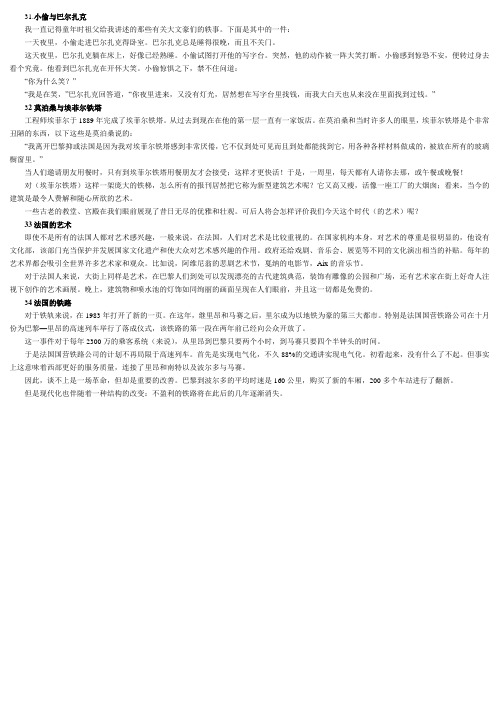
31.小偷与巴尔扎克我一直记得童年时祖父给我讲述的那些有关大文豪们的轶事。
下面是其中的一件:一天夜里,小偷走进巴尔扎克得卧室。
巴尔扎克总是睡得很晚,而且不关门。
这天夜里,巴尔扎克躺在床上,好像已经熟睡。
小偷试图打开他的写字台。
突然,他的动作被一阵大笑打断。
小偷感到惊恐不安,便转过身去看个究竟。
他看到巴尔扎克在开怀大笑。
小偷惊惧之下,禁不住问道:“你为什么笑?”“我是在笑,”巴尔扎克回答道,“你夜里进来,又没有灯光,居然想在写字台里找钱,而我大白天也从来没在里面找到过钱。
”32莫泊桑与埃菲尔铁塔工程师埃菲尔于1889年完成了埃菲尔铁塔。
从过去到现在在他的第一层一直有一家饭店。
在莫泊桑和当时许多人的眼里,埃菲尔铁塔是个非常丑陋的东西,以下这些是莫泊桑说的:“我离开巴黎抑或法国是因为我对埃菲尔铁塔感到非常厌倦,它不仅到处可见而且到处都能找到它,用各种各样材料做成的,被放在所有的玻璃橱窗里。
”当人们邀请朋友用餐时,只有到埃菲尔铁塔用餐朋友才会接受;这样才更快活!于是,一周里,每天都有人请你去那,或午餐或晚餐!对(埃菲尔铁塔)这样一架庞大的铁梯,怎么所有的报刊居然把它称为新型建筑艺术呢?它又高又瘦,活像一座工厂的大烟囱;看来,当今的建筑是最令人费解和随心所欲的艺术。
一些古老的教堂、宫殿在我们眼前展现了昔日无尽的优雅和壮观。
可后人将会怎样评价我们今天这个时代(的艺术)呢?33法国的艺术即使不是所有的法国人都对艺术感兴趣,一般来说,在法国,人们对艺术是比较重视的。
在国家机构本身,对艺术的尊重是很明显的,他设有文化部,该部门充当保护并发展国家文化遗产和使大众对艺术感兴趣的作用。
政府还给戏剧、音乐会、展览等不同的文化演出相当的补贴。
每年的艺术界都会吸引全世界许多艺术家和观众。
比如说,阿维尼翁的悲剧艺术节,戛纳的电影节,Aix的音乐节。
对于法国人来说,大街上同样是艺术,在巴黎人们到处可以发现漂亮的古代建筑典范,装饰有雕像的公园和广场,还有艺术家在街上好奇人注视下创作的艺术画展。
道教文化与汉英翻译

道教文化与汉英翻译Taoist Culture and C-E Translation▪道教文化背景知识Taoist Culture道家Philosophical Taoism道敎Religious Taoism起源:OriginTaoist organizations:张道陵Zhang Daoling 五斗米道西晋Taoist doctrines:老子李耳Laozi 唐高祖李渊Tang Dynasty老子Laozi▪老子Laozi, honorific title老“venerable”, “old”子“master”, honorific suffix李耳Li Er, 字伯阳Boyang (courtesy name)▪道家学派始祖founder of philosophical Taoism▪《道德经》Tao Te Ching▪宇宙哲学Chinese cosmogony▪信仰:Beliefs▪Tao “way”, “path”▪無為Wu wei “without action”无为而治,不言之教Hayek:spontaneous orderJames Dorn: minimizing the role of government and letting individuals develop spontaneously would best achieve social and economic harmony.▪三宝▪慈compassion俭moderation (Thrift)不敢为天下先humility▪朴simplicity, the primordial state of tao▪去甚,去奢,去泰Discarding extremes, extravagance and excess▪少私寡欲wipe out selfish desires▪清静恬淡live a quiet life/ quiet world▪知足常乐the attitude of contentment on what one owns道教经典英译▪道生一,一生二,二生三,三生万物。
第4课 电子词典、工具书与翻译实践
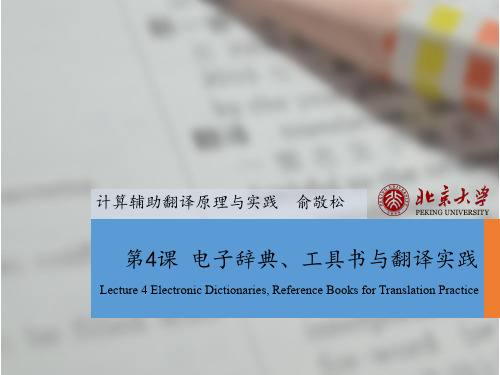
Longman 电子词典
Longman 电子词典
Longman 电子词典
Longman 电子词典
Longman 电子词典
Longman 电子词典
Collins Cobuild 词典
Collins Cobuild 词典
Collins Cobuild 词典
Collins Cobuild 词典
英语
韦氏词典 牛津英语词典 剑桥英语词典 Urban dictionary reference Onelook yourdictionary thefreedictionary 同义词反义词词典 缩略语词典
德语 法语 日语
学科 计算机
工具书
URL链接 /contents.html /resources/dictionary/
杂的关联 2. 加强对多部工具书的整合
工具书编纂模式的变革
•工具书的基本单位我们期望将不再是以词头 为核心,而是知识元。
•一个知识元中包含更为丰富的面向翻译的属
性及知识元间的关联
•如音标、拼写、领域、文体、语式、义项、
例句、上位概念、下位概念、其他聚类概念等
电子工具书的未来(2)
• 面向学习,面向语言产出
计算辅助翻译原理与实践
俞敬松
第4课 电子辞典、工具书与翻译实践
Lecture 4 Electronic Dictionaries, Reference Books for Translation Practice
电子工具书综述
• 参考工具书是一种按特定形式编排,专供查找特
定信息的特殊文献资料。 •金常政在《百科全书学》一书中定义:
金融
/glossary/ /glossary/ /wiki/detail/wordBig+Board.html
《文化与翻译》课件

的表达。
语境依赖性
02
文化负载词的含义往往依赖于特定的语境和文化背景。
语义模糊性
03
由于文化差异,某些文化负载词在目标语言中的语义可能不明
确或产生歧义。
文化负载词的翻译策略
直译与意译
直译保留原词的形象和 文化色彩,意译则更注
重传达意义。
加注解释
对于某些具有深厚文化 内涵的词汇,可以通过 加注来解释其文化背景
解。
语境理解
不同文化对语境的理解和运用存 在差异,可能影响信息的准确传
递。
翻译在跨文化交际中的作用
信息传递
翻译能够将一种语言的文本或口头表达转换为另 一种语言,帮助克服语言障碍。
文化交流
翻译是文化交流的重要桥梁,有助于促进不同文 化之间的相互了解和认同。
跨文化合作
在跨国合作、商务谈判、国际交流等领域,翻译 是实现有效沟通的关键。
精神文化负载词
如“道”在英语中被译为“Tao”,并阐述其哲学思想和文化内 涵。
05
文化背景知识在翻译中的 重要性
了解文化背景知识对翻译的帮助
避免文化误解
对目标语言的文化背景有深入了解,可以避免在翻译过程中产生文 化误解,确保信息的准确传达。
提高翻译质量
掌握文化背景知识有助于更准确地理解原文,从而提升翻译的准确 性和流畅性。
文化意象
文化意象的传递对于翻译 至关重要,译者需准确传 达原文的文化意象。
翻译在文化传播中的作用
文化交流
翻译是跨文化交流的重要桥梁,有助 于不同文化之间的相互了解与借鉴。
文化创新
翻译过程中可能会产生新的表达方式 和文化现象,推动文化的创新与发展 。
文化传承
通过翻译,可以将文化遗产传承下去 ,让更多人了解和欣赏各种文化。
武汉理工大学 文化与翻译课程讲义
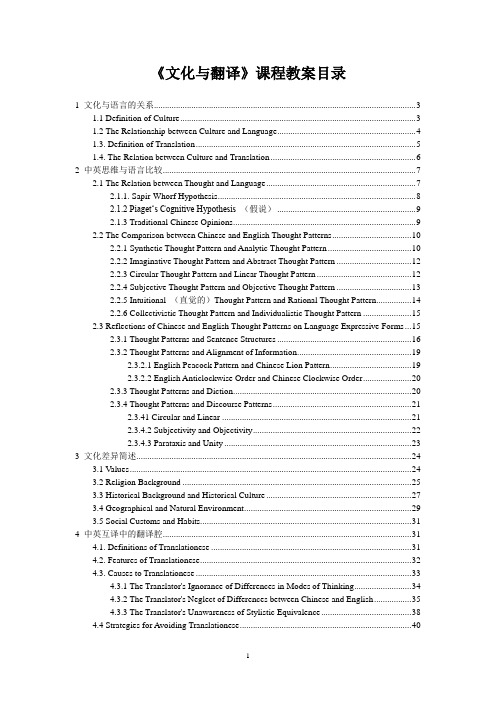
《文化与翻译》课程教案目录1 文化与语言的关系 (3)1.1 Definition of Culture (3)1.2 The Relationship between Culture and Language (4)1.3. Definition of Translation (5)1.4. The Relation between Culture and Translation (6)2 中英思维与语言比较 (7)2.1 The Relation between Thought and Language (7)2.1.1. Sapir-Whorf Hypothesis (8)2.1.2 Piaget...s Cognitive Hypothesis (假说) (9)2.1.3 Traditional Chinese Opinions (9)2.2 The Comparison between Chinese and English Thought Patterns (10)2.2.1 Synthetic Thought Pattern and Analytic Thought Pattern (10)2.2.2 Imaginative Thought Pattern and Abstract Thought Pattern (12)2.2.3 Circular Thought Pattern and Linear Thought Pattern (12)2.2.4 Subjective Thought Pattern and Objective Thought Pattern (13)2.2.5 Intuitional (直觉的)Thought Pattern and Rational Thought Pattern (14)2.2.6 Collectivistic Thought Pattern and Individualistic Thought Pattern (15)2.3 Reflections of Chinese and English Thought Patterns on Language Expressive Forms (15)2.3.1 Thought Patterns and Sentence Structures (16)2.3.2 Thought Patterns and Alignment of Information (19)2.3.2.1 English Peacock Pattern and Chinese Lion Pattern (19)2.3.2.2 English Anticlockwise Order and Chinese Clockwise Order (20)2.3.3 Thought Patterns and Diction (20)2.3.4 Thought Patterns and Discourse Patterns (21)2.3.41 Circular and Linear (21)2.3.4.2 Subjectivity and Objectivity (22)2.3.4.3 Parataxis and Unity (23)3 文化差异简述 (24)3.1 Values (24)3.2 Religion Background (25)3.3 Historical Background and Historical Culture (27)3.4 Geographical and Natural Environment (29)3.5 Social Customs and Habits (31)4 中英互译中的翻译腔 (31)4.1. Definitions of Translationese (31)4.2. Features of Translationese (32)4.3. Causes to Translationese (33)4.3.1 The Translator's Ignorance of Differences in Modes of Thinking (34)4.3.2 The Translator's Neglect of Differences between Chinese and English (35)4.3.3 The Translator's Unawareness of Stylistic Equivalence (38)4.4 Strategies for Avoiding Translationese (40)4.4.1 To Improve Translator's Translating Proficiency (40)4.4.2 To Study the Original Text Carefully (42)5 翻译理论和策略简介 (43)5.1 Equivalence Theory (43)5.1.1 Equivalence-based Linguistic Approach (44)5.1.2 Equivalence-based Cultural Approach (44)5.1.3 Nida‟s Formal Equivalence vs. Dynamic/Functional Equivalence (45)5.1.5 Baker‟s Approach to Translation Equivalence (47)5.1.6 Venuti‟s Foreignization (异化)and Domestication (归化) (48)5.2 Functional Translation Theory (49)5.2.1 Reiss‟ Text Typology (类型学) Theory (49)5.2.2 Vermeer‟s Skopostheorie (翻译目的论) (50)5.2.2.1 Skopos Rule as a Guiding Principle (50)5.2.2.2 Coherence Rule and Fidelity Rule as Subordinate (从属的) Principles (51)5.3 Summary (51)6 翻译中文化负载词的处理 (52)6.1 Practical Principles for the C-E Translation of CLCTs (52)6.1.1 Adoption of the Established Translations (53)6.1.2 Full Consideration of Cultural Differences and Achieving Cultural Equivalence . 536.1.3 Considering the Purpose of Text and Purpose of Translation (53)6.2 Suggested Approaches (55)6.2.1 Transliteration (55)6.2.2 Transliteration with Explanation (56)6.2.3 Literal Translation (57)6.2.4 Literal Translation with Explanation (57)6.2.5 Paraphrasing (58)6.2.6 Adaptation (59)6.2.6.1 Addition (59)6.2.6.2 Subtraction /Deletion /Omission of Clichés /Redundant Expression andRhetoric (60)7 翻译案例分析 (65)7.1 Principles Guiding Subtitle Translation (65)7.1.1 Conciseness (65)7.1.2 Immediate Comprehensibility (65)7.1.3 Promoting the Portrayal of Character (66)7.1.4 Emotion Provoking (67)7.2 Introduction of subtitle translation strategies (68)7.3 Subtitle translation strategies (69)7.3.1 Condensation (69)7.3.2 Deletion (69)7.3.3 Expansion (70)7.3.4 Paraphrase (70)1 文化与语言的关系1.1 Definition of CultureIf we look back upon the historical origin of culture, we can find that the word culture was first used in Chinese ancient books. Its meaning is opposite to uncivilized, pristine and wildness, and has great differences with the meaning of culture which we use today. Nowadays, the word culture is original from the Latin word "cultus" which stems from "colere" (tend, cultivate). In late Middle English, the sense was "cultivation of soil" and from this (early 16th century) arose the present meaning of "cultivation of the mind, faculties and manners". The meaning of English culture is related to politics, law, and education etc. From the end of the 19th century, scholars around the world tried to give a definite definition to culture.However, the definitions vary a lot from each other by now.The earliest and the most widely acknowledged definition of culture was given by the British anthropologist Edwar Tylor in his Primitive Culture (1871). He puts forward the first important anthropological definition of culture.Culture is that complex whole which includes knowledge, belief, art, morals, law, custom, and any other capabilities and habits acquired by man as a member of society(Tylor,1871:1)More specifically concerned with language and translation, in A Textbook of Translation, Peter Newmark defines culture as "the way of life and its manifestations that are peculiar to a community that uses a particular language as its means of expression" (Newmark, 1988:94) Daniel Bates and Fred Plog propose a descriptive definition "Culture is a system of shared beliefs, values, customs, behaviors and artifacts that the members of a society use to cope with their world and with one another, and that are transmitted from generation to generation through learning" (Samovar & Porter, 2000:36)Vermeer focuses more on norms and conventions as the main features of a culture. For him, a culture is the entire setting of norms and conventions that an individual as a member of his society must know in order to be like everybody or to be able to be different from everybody. (Nord, 2001:33)Using these descriptions as a starting point, Samovar and Porter advance to the following definition:The deposit of knowledge, experience, beliefs, values, actions, attitudes, meanings, hierarchies, religion, notions of time, roles, spatial relations, concepts of universe, and artifacts acquired by a group of people in the course of generations through individual and groupstriving. (Samovar&Porter, 2000: 36)In China, Deng Yanchang and Liu Runqing hold the view that "culture refers to the entire way of life of a society", that is, "the total pattern of beliefs, customs, institutions, objects, and techniques that characterize the life of human community".(Deng&Liu,1989:3)According to Microsoft Encarta Encyclopedia (2002), culture, in anthropology, is the patterns of behavior and thinking that people living in social groups learn, create, and share. Culture distinguished one human group from others. It also distinguished human from other animals. A people's culture includes their beliefs, rules of behavior, language, ritual, art, technology, styles of dress, ways of producing and cooking food, religion, and political and economic systems.According to the above definitions given by famous experts and the dictionary, we can see that culture is a quite universal, multi-dimensional, complex and all-pervasive concept. Based on the features of culture mentioned above, the meaning of culture can be understood from the following aspects: (1) ideological culture, which refers to psychological structure, ways of thinking and value system; (2) system culture, which comes down from the past generation, or changes continuously, or exists by all sorts of codes and regulations; (3) material culture, which is made by people and serves people, such as house, clothes, etc.1.2 The Relationship between Culture and LanguageIt has been widely recognized that language and culture are inseparable. Nida points out "Since culture is defined succinctly as totality of beliefs and practice of a society, nothing is of greater strategic importance than the language through which its beliefs are expressed and transmitted and by which most interaction of its members takes place. When it is used in contexts of communication, it is bound up with culture in multiple and complex ways:' (Nida, 2000:105) The anthropologist Huckhohn also thinks that human culture without language is unthinkable. I would like to analyze the relationship between culture and language from the following three aspects.First, language is a part of culture. According to the definition of culture given by Microsoft Encarta Encyclopedia, a people's culture includes their beliefs, rules of behavior, language, ritual, art, technology, style of dress, ways of producing and cooking food, religion, and political and economic systems. We can draw a conclusion that language is a component of culture. Secondly, language is the carrier of culture and language reflects culture. As Mr. Xu Guozhang says that“语言是人类特有的一种符号系统,当它作用于文化的时候,它是文化信息的载体和容器。
- 1、下载文档前请自行甄别文档内容的完整性,平台不提供额外的编辑、内容补充、找答案等附加服务。
- 2、"仅部分预览"的文档,不可在线预览部分如存在完整性等问题,可反馈申请退款(可完整预览的文档不适用该条件!)。
- 3、如文档侵犯您的权益,请联系客服反馈,我们会尽快为您处理(人工客服工作时间:9:00-18:30)。
4.1.3 Translation practice
1. to show one’s face, to
1. 露面 2. 丢脸 3. 碰壁 4.热心 5.祸不单行 6.趁热打铁 7.混水摸鱼 8.一只耳朵进, 一只耳朵出
show up 2. to lose face 3. run one’s head against a wall 4.kind/warm-hearted 5.misfortunes never come singly/alone 6.srike while the iron is hot 7.to fish in troubled waters 8.to go in at one ear and out at the other
1.2 Classification of culture
1.2.1 Classification by ethnolinguistics 文化语言学的分类
1) 物质文化(material culture) 2) 制度文化(institutional culture) 3) 精神文化( mental culture):
《东西方文明之根本差异》(李大钊)
“东西方文明有根本不同之点,即东洋文化主静,
西方文明主动是也。……一为自然的,一为人为的; 一为安息的,一为战争的;一为消极的,一为积极 的;一为依赖的,一为独立的;一为苟安的,一为 实进的;一为因袭的,一为创造的;一为保守的, 一为进步的;一为直觉的,一为理智的;一为空想 的,一为体验的;一为艺术的,一为科学的;一为 精神的,一为物质的;一为灵的,一为肉的;一为 向天的,一为立地的;一为自然支配的,一为人间 征服自然……”
3. Culture in idiom
突出表现为概念相似(denotation)、语用意义
(connotation)不同 1.打草惊蛇----to beat about the bush 打草惊蛇: to alert the enemy by rush or accidental events before carrying out the planned attack; to beat about the bush: to approach a subject without coming to the point, try to say something indirectly(旁敲侧击,拐弯抹角). 2. 翻天覆地----to move heaven and earth 翻天覆地:epoch-making, earth-shaking To move heaven and earth: to do one’s utmost (千方百计)
from different angles. 涵盖面最广的是Edward Tylor 1871年在《原始文化》 一书中提出的:“所谓文化和文明乃是包括知识、 信仰、艺术、道德、法律、习俗以及包括作为社会 成员的个人而获得的其他任何能力、习惯在内的一 种综合体。” “That complex whole which includes knowledge, belief, art, morals, law, custom, and any other capabilities and habits acquired by man as a member of society.”
(psychology culture心理文化和 idea culture观念文化)
1.2.2 Classification by Nida 奈达的分类
1) Ecology Culture 生态文化 2) Material Culture 物质文化
社会文化 4) Religious Culture 宗教文化 5) Linguistic Culture 语言文化
4.1 词义相符(semantic correspondence)
semantic correspondence:指称意义和蕴涵意义
相符;---翻译策略:直译 4.1.1 有些词语在没有特指语境的情况下,只具备 指称意义(denotation/referential meaning)。 山(mountain)、水(water)、湖泊(lake)、森林 (forest)、阳光pple)、蔬菜(vegetable)、医生(doctor)、学校 (school)、工厂(factory)、教师(teacher)、历史博 物馆(history museum)、历史遗产(historical heritage)、温室效应(green-house effect)、环境 保护(environment protection)等。
semester and last class. For example: The difference of thinking habits between British and Chinese brings about the syntactic differences, to be specific, that is, the difference between: Hypotaxis (形合) and parataxis (意合), subject-predicate structure and topic structure, active voice and passive voice , affirmative sentence and negative sentence , Initial(head) focus and final (end) focus
1、概念意义的空缺(semantic zero/lexical
gap)
盘古、女娲、秀才、八股文、太极拳 etc.
2、相同词语在文化内涵上的差别(cultural
difference in vocabulary):
龙(高贵,威严,吉祥)---dragon (violent, evil) 红(喜庆)----red (violent) 绿(茂盛、喻娼家男子)----green
(immature/inexperienced/ill) 白(反动、丧事)----white (pure/honorable) 黄(皇帝、色情)---yellow (cowardly/envious)
2. Culture in grammar system
Refer to linguistic differences discussed last
3) Social Culture
1.3 The close relationship between language and culture (语言和文化密不可分)
Language and culture are interdependent and
inseparable. Language is the carrier of culture, and culture governs the language. They are interactive, and help each other progress and develop. 语言是文化的一部分(part of culture),文化又无时 无刻影响着语言. 语言是文化的载体(vehicle/carrier ),又是文化的 写照(reflection). 语言文字当中,处处都打有文化的烙印(language bear a marked brand of culture),语言活动过程 中,时时可觅见文化的踪迹(trails of culture)
4. Culture in language use
1. 老李(to show one’s respect)----old Li
(unpleasant ):(“老” 字在汉语文化 中具有独特的文化语用含义,与年龄没有 必然联系(老大,老板,老爷,老师,老 兄)
2. 不敢当,哪里哪里----thank you:(自
谦在汉语文化中是一种美德,与实际状况 无关)
III. Comparison of thinking mode between Chinese and English (refer to the textbook: P25-32)
1. 中国人注重伦理(ethics),英美人注重认知
(cognition)。 2. 中国人重整体(integrity)、偏重综合性 (synthetic)思维,英美人重个体(individuality)、 偏重分析性(analytic)思维。 3. 中国人重直觉(intuition),英美人重实证 (evidence)。 4. 中国人重形象思维(figurative thinking),英 美人重逻辑思维(logical thinking)。
II. Culture in language
1. 词汇中的文化(in lexical system)
2. 语法结构中的文化(in grammar)
3. 习语中的文化(in idiom)
4. 语用中的文化(in language use)
1. Culture in lexical system
past and it will guide your future.)
登幽州台歌 (陈子昂)
前不见古人,
Looking back, I do not see
the ancients, 后不见来者。 Looking ahead, I can’t see 念天地之悠悠, the wise ones to come. Brooding on the endless 独怆然而涕下。 universe, Alone, in my sorrow, tears stream down.
